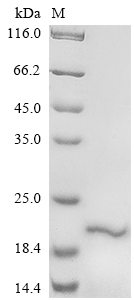This is a recombinant fragment of human Delta‑like protein 3 (DLL3), spanning amino acids 383–492, expressed in E.coli with an N‑terminal 6×His‑SUMO tag and purified to >85% by SDS‑PAGE. It has a molecular weight of ~24.2 kDa and is supplied as liquid or lyophilized powder to meet different requirements.
Potential Applications
Note: The following applications are based on the known biological functions of DLL3 protein and scientific literature predictions. Our company has not validated all listed applications, and specific effects need to be verified by customers according to their experimental requirements. We recommend conducting small-scale preliminary experiments before formal studies.
1. Study of the DLL3 C-terminal Functional Domain
Application:
Used to study the specific functions and regulatory roles of the C-terminal region (383–492aa) of DLL3. It can help compare with full-length DLL3 to understand its role in protein stability and function. It is also useful for analyzing truncated mutants and for studying how this region affects the protein’s overall shape and activity.
Scientific Basis:
The C-terminal region of DLL3 contains important regulatory sequences. Its integrity is essential for correct folding and proper function.
2. Development of Domain-Specific Antibodies
Application:
Serves as a specific antigen for developing monoclonal antibodies targeting the C-terminal region of DLL3. It can be used to screen region-specific antibodies, verify binding by ELISA and Western blot, develop C-terminal-based detection methods, and create diagnostic tools that distinguish full-length from truncated DLL3.
Scientific Basis:
Antibodies that recognize the C-terminal region can detect different DLL3 forms and cleavage products. This may help in tumor classification and prognosis.
3. Epitope Mapping for Protein Interactions
Application:
Used to pinpoint interaction sites within the DLL3 C-terminal region. Yeast two-hybrid screening can identify specific binding partners. GST pull-down assays can confirm known interactions. Peptide competition experiments can locate key binding sequences. Truncated mutants can be used to study functional impacts.
Scientific Basis:
C-terminal regions often contain important binding motifs, which are critical for understanding protein interactions and functions.
4. Immunoassay Optimization
Application:
Used to improve the specificity of DLL3 detection methods. It can act as a competing antigen in competitive ELISA, serve as a blocking control in IHC staining, help develop sandwich ELISA based on C-terminal epitopes, or validate cross-reactivity in multiplex immunofluorescence.
Scientific Basis:
Using recombinant protein fragments can increase the specificity and accuracy of immunoassays.
5. Study of Protein Stability and Folding
Application:
Used to explore the folding properties and stability of the DLL3 C-terminal region. Circular dichroism (CD) can reveal its secondary structure. Dynamic light scattering (DLS) can assess aggregation. Thermal stability tests can evaluate its folding robustness. The fragment’s behavior under different conditions can also be studied.
Scientific Basis:
Understanding the folding of individual regions supports structural and functional studies of the full-length protein.
6. Biomarker Development
Application:
Used to develop assays that detect the C-terminal fragment of DLL3 as a specific biomarker. ELISA can be set up to measure this fragment in serum. It can help track DLL3 cleavage products. Tissue-specific staining protocols and peptide chip platforms can also be developed.
Scientific Basis:
Different parts of DLL3 may have distinct biological roles. C-terminal-specific detection could help in disease diagnosis and monitoring.
7. Vaccine Antigen Design
Application:
Used as a potential antigen in DLL3-based cancer immunotherapy. This fragment’s ability to trigger specific immune responses can be tested. Epitope mapping can help design effective peptide vaccines. It can also be combined with other tumor antigens in multivalent vaccine strategies.
Scientific Basis:
Smaller protein fragments may reduce the risk of non-specific immune responses, making them more suitable as vaccine antigens.






